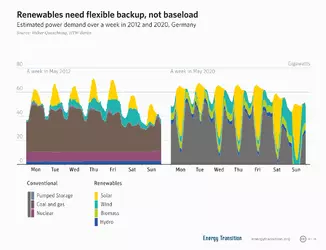Most of it is incorrect.
I predict a lot of seething from climate change activists who believe that wind and solar are the cheapest forms of energy.
PV solar at a utility scale has by far the lowest LCOE of any power source and it's the reason the majority in growth of electricity production worldwide has been solar every year for a long while now, PV costs have cratered by 90% since the aughts. For every meme headline about China opening a new coal plant, they add ten times that in PV capacity.
Trump is right though, renewables are the most expensive form of electricity because they’re so unreliable that they need either an enormous amount of overproduction and batteries or a backup generator. If you need a backup plant that can deliver all of the energy of your renewable plant, why not always use the “backup” then?
No such thing as a "backup plant". There are base load sources of production that are never turned off (nuclear, hydroelectric, most coal plants) and then load following or peaker plants (sources of electricity, usually gas, that are either tuned up or down to follow demand and keep the grid balanced, or are only activated to stabilize peak demand, respectively). Every grid uses them to prevent brownouts, but there is a reason they are not employed for base load, they are very inefficient since they are built with the capability to be adjusted or turned on or off at a moment's notice, unlike for example combined cycle gas generation that is always producing at the same rate and are more efficient.
The good thing about solar specifically is that production tends to follow demand naturally, which stabilizes the grid. Most electricity consumption happens during midday when people are awake, which is when PV production peaks, electricity consumption peaks in summer due to AC which is when PV production peaks etc. You don't need a "backup" that covers the ENTIRE CAPACITY of PV, you need a base load that covers the lower demand during nighttime, then a few peaker plants to kick in during the afternoon when people return home and start pulling more power to take the edge off.

This requirement for intermittent power can be reduced even further if electricity demand is shifted to times of peak renewables production, such as industrial cooling, basicaclly a reverse of off-peak nighttime electricity costs.
You can buy an enormous amount of fuel for the cost of a wind/solar farm, which by the way, is a recurring expense since panels degrade and windmills wear out over time.
That's what LCOE means, the levelized cost of electricity including all expenses, upfront capital, fuel, maintenance, and PV is still the cheapest due to low upfront cost. Nuclear is obviously the most expensive due to insane upfront costs, surge time gas is close, but it isn't a regular occurrence, average gas generation is cheaper albeit more expensive than PV. And that's only on the financial side, it ignores the environmental impact of fossil fuels, because polluting is "free". Not touching the storage argument because arrays of Li-ion batteries are indeed a poor solution for energy storage, there is no real solution for power storage at scale, it's better to offload electricity demand to peak renewable production and just minimize the basal load need as much as possible. Pumped storage works, but it's very location dependent. On paper PV with onsite storage is "the same LCOE" as a comparable gas plant but there's more to life than the economic argument, battery arrays are too crude and shouldn't be used.
Correct, Chinese firms revolutionized PV and cheers to them, it's done a lot of good. Sucking off Arab circumcised Muslim phallus is not a laudable goal.



